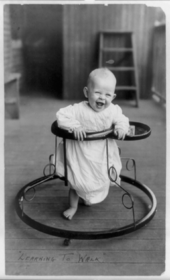Baby walker
A baby walker (also called a walker , walking school, baby walker) is a seating device in a frame on several wheels for infants with which they can move by kicking. This greatly increases the child's range of motion. Often a kind of table is attached, which is either used in the form of a storage surface or serves as a game board with rattles or figures.
history

The history of baby walkers goes back at least to the 15th century. The devices are mostly referred to as "gängelwagen", although the meaning of the word gängeln was not negatively connoted until the 18th century. Gängeln simply means “to lead while walking”. In the 18th century the meaning of the word gängeln changed and so did the attitude towards baby walkers. Critical voices increased who described technical aids for learning to walk as unnecessary and potentially dangerous. Although the criticism of baby walkers continues to this day, carts are still manufactured and used.
criticism
The so-called baby walkers hinder normal physiological movement. By hanging in the baby walker, children learn a wrong gait pattern, which often requires treatment. It can also lead to malpositions of the feet and shortened muscles. The child's entire walking apparatus can be affected by a baby walker.
With the help of the baby walker, children can move at up to 10 km / h for a short time, which increases the risk of injury (e.g. from being crushed or falling down stairs). Every year around 6000 children in Germany injure themselves with baby walkers, which is why the professional association of paediatricians (BVKJ) has been advocating their ban for years. In Canada, baby walkers were banned in April 2004 after surveys from 1990 to 2002 indicated 1935 accidents.
Web links
Individual evidence
- ↑ DWDS, Etymological Dictionary
- ↑ For example, Immanuel Kant criticizes the walking cart; Immanuel Kant: Answering the question: what is enlightenment? In: Wilhelm Weischedel (ed.): Immanuel Kant. Writings on anthropology, philosophy of history, politics and education. Darmstadt 2005, pp. 53-61.
- ^ Diana Daniel, Marius Hug: Increased mobility through deprivation of liberty? A cultural history of the 'Gängelwagen' from 1500–2000. In: Marcello Caruso, Christian Kendung (ed.): Machines. Yearbook for Historical Educational Research 2014. Bad Heilbrunn, pp. 21–46.
- ↑ The Baby Bouncer and the walker "baby walker" Rabeneltern.org, accessed October 25, 2013.
- ↑ European Child Safety Alliance and ANEC joint position statement: Baby walkers
- ↑ Pediatricians on the Internet: News from November 26th, 2003: "Baby walkers - increased risk of accidents"
- ↑ http://www.hc-sc.gc.ca/sr-sr/activ/consprod/baby-bebe-eng.php

